The Source of Sound 113: music from Gabon, from the period just after WWII
This second episode of The Source of Sound is about the music of Gabon. In the first episode (of 11 April), we heard the recordings that Pierre Sallée made in Gabon, which were released on vinyl and CD. Today is about the recordings from just after the Second World War. They come from the archives from 1946, made by Gilbert Rouget, and from three LPs ‘Anthologie de la Vie Africaine Congo-Gabon’ that feature recordings made by Herbert Pepper between 1941 and 1956. We end the show with a field recording from Pierre Sallée from 1967 that has never been published.
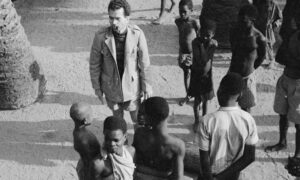
Pyral
Gilbert Rouget travelled in 1946 in the (at that time) French part of Central Africa, together with a film and audio crew. The sound was recorded on special transcription disks, Pyral lacquers (from the French manufacturer Pyral). This system allowed them to do the sound-recording directly on to the disks, which resulted in a much better quality than with the phonographic cilinders used before that. It did mean carrying around a lot of equipment, which was done mostly by manual labor in Gabon and Congo. They also needed specialists like, audio technician André Didier, to operate the equipment and, if necessary, repair it. The released recordings played an important part at the first exposition of the CoBrA art movement in Amsterdam, and continued their influence later in the 1950s and onwards.
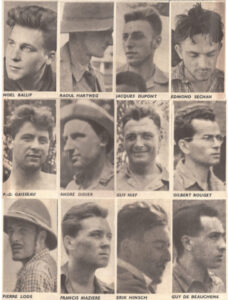
Rowing songs and dance songs
We start this episode with a dance for women from the Okande, followed by a recording of one of the rowing boats used by Rouget and company. A rowing boat with a 15 men crew; you can hear the water, the oars, the ship’s bell and the horn to warn the people with, demonstrating that environmental sounds (or noise) were already recorded at that time.
It is followed by a song of the rowers and then a song from the bearers, who carried important or sick people around in a kind of litter in those days. They had also had to announce the important person they carried. Subsequently two dance songs, one for men and one for women, with percussion playing an important part.
After this, we hear three dance songs in which the sanza or mbira (a kind of lamellophone) plays an important part. Then followed by two dance songs that feature percussion again. This first part finishes with a rhythmic speech from the master of the boat to his crew, talking about the journey and the reward, the white people and the rapids.
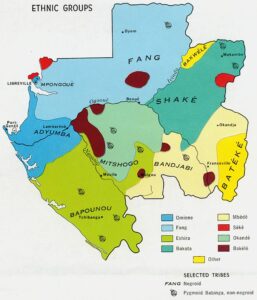
Herbert Pepper
In the second part of this Source of the Sound, we listen to some tracks recorded by Herbert Pepper in Gabon between 1941 and 1956. They were released on three different LPs titled ‘Anthologie de la Vie Africaine (Congo-Gabon)’ in 1958, including extensive information, drawings and photos. Unfortunately, they are mostly short fragments, as they apparently thought at the time that not many people would be interested in longer recordings. For example, there is an epic that takes a whole night, but is represented by a fragment that takes only one-and-a-halve minutes.

The harp
First, a dance song with guitar, in which the leader of the dance indicates the movements. In that time, it is a modern song from the city. Then, a section about the origin of the players of the Mvet, the harp-lute, from the bard Edou-Ada-Luc. After that, another story is sung and played by Philippe Dong. An ode to the Ngombi follows, a harp for devotees of the Bwiti faith. To them, the harp is a sacred instrument that can communicate with the spirits and give insight into the present and the future. A harp song comes after that, which tells about the return of a dead person.
The second part of this episode ends with a conversation and plea with the spirit Okouyi to receive judgment in a local court case and to pay homage to the great crocodile master.

Bwiti
We end the episode with the beginning of a Bwiti seance, recorded by Pierre Sallée in 1967, in which there is a prominent role for the musical bow.

Playlist
01 Danse des F Okande Eniga Bwende 2 1’05 1’05
Singers and choir female with copper bells attached to their belts, 3 drums played by 2 men
Recorded on Pyral Disc by a team led by Gilbert Rouget, 1946
Location Boue, Achuka in Gabon
Culture Okandé
https://archives.crem-cnrs.fr/archives/items/CNRSMH_I_1974_013_048_03/
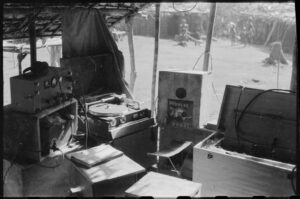
02 Chant des piroguiers 8 ambiance, trompe 2’28 4’33
Recorded on Pyral Disc by a team led by Gilbert Rouget, 1946
Location Lastourville
Culture Baduma
https://archives.crem-cnrs.fr/archives/items/CNRSMH_I_1974_013_043_08/
It is a part of the rowing songs recorded by Rouget at this time. One can hear the oars in the water, the sound of the horn of the antelope, the iron bells which are hung in the front of the boat and the crew of 15 members while going down the river.
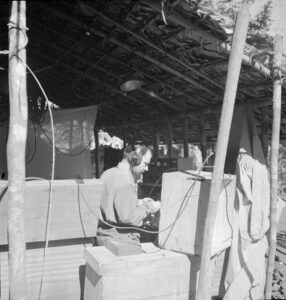
02 Chant des piroguiers 8 ambiance, trompe 2’28 4’33
Recorded on Pyral Disc by a team led by Gilbert Rouget, 1946
Location Lastourville
Culture Baduma
https://archives.crem-cnrs.fr/archives/items/CNRSMH_I_1974_013_043_08/
It is one of the many rowing songs recorded by Rouget at this time. One can hear the oars in the water, the sound of the horn of the antelope, the iron bells which are hung in the front of the boat and the crew of 15 members while going down the river.

03 Chant des piroguiers 10 4’01 8’34
Recorded on Pyral Disc by a team led by Gilbert Rouget, 1946
15 crew members and singers.
Location Lastourville
culture Baduma
https://archives.crem-cnrs.fr/archives/items/CNRSMH_I_1974_013_043_10/
One can still hear the water, bells and oars while they are singing.
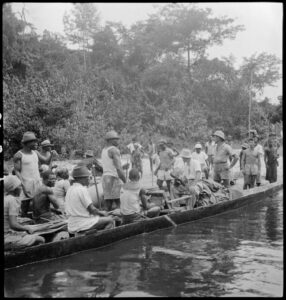
04 Chant des tipoyeurs 5a 2’29 11’03
10 carriers of people of importance or sick ones. They were carried while sitting in a kind of chair.
Location Lastourville
Culture Bawandji (ou Awandji, Baouandji)
Recorded on Pyral Disc by a team led by Gilbert Rouget, 1946
https://archives.crem-cnrs.fr/archives/items/CNRSMH_I_1974_013_045_10/
The songs of the tipoyeurs were different from the usual porters of goods. They had with their singing also to impress the people where they arrived or passed of the importance of the one they carried.

05 Danse des Bawumbu 2 Basebam 3’25 14’28
3 Nzinzi (drums), Nguta (rattles), Masoku (bells), mixed choir and singers
Location Franceville, Mounzai
Culture Bawumbu
Recorded on Pyral Disc by a team led by Gilbert Rouget, 1946
https://archives.crem-cnrs.fr/archives/items/CNRSMH_I_1974_013_041_06/
The singers and dancers are paint as for a funeral. The song is about going to fish and catch a lot.

06 Danse Mawakue 2 3’34 18’02
1 female singer, 4 men choir, 2 drums, bells, sticks
Location Lastourville, Mukumamuyabi
Culture Shake
Recorded on Pyral Disc by a team led by Gilbert Rouget, 1946
https://archives.crem-cnrs.fr/archives/items/CNRSMH_I_1974_013_044_01/
Women danse, the main singer has the face painted white and red and white suns painted on her shoulder and while dancing she also directs the drummers and choir with a wooden sculpted andromorphic handle. The musicians were called up by the district commissioner.

07 Danse Mawunda 1 3’59 22’01
Patrice Mabuedi – voice, 4 Marombe idiophone instruments, 1 Sanzi (lamellophone), Malulu and Gota rattles
Location Kankan
Culture Baduma
Recorded on Pyral Disc by a team led by Gilbert Rouget, 1946
https://archives.crem-cnrs.fr/archives/items/CNRSMH_I_1974_013_046_09/
It is dance with the men sitting on the ground and move only their torso, head and hands. The sanzi has 10 metal blades with a small metal ring glued to the body of the instrument which causes the buzzing sound. The marombe are 4 tubes of bamboo of a different length and closed on one side. One hits the ground with the open side while opening or closing the hole. The Malulu consists of 3 small calabashes filled with grains and threaded along a stick which serves as a handle and is combined with a Gota rattle.

08 Chant de danse 2 Sere 4’23 26’24
Patrice Mabuedi – voice, 2 rattles, 1 sanzi
Location Kankan
culture Baduma
Recorded on Pyral Disc by a team led by Gilbert Rouget, 1946
https://archives.crem-cnrs.fr/archives/items/CNRSMH_I_1974_013_047_03/
Festive dance, recorded out of context
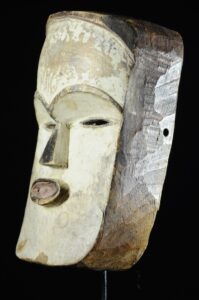
09 Danse Mawunda 5 3’07 29’31
Patrice Mabuedi – voice, 2 rattles, 1 sanzi, 4 Marombe, the choir were the rowers
Location Kankan
Culture Baduma
Recorded on Pyral Disc by a team led by Gilbert Rouget, 1946
https://archives.crem-cnrs.fr/archives/items/CNRSMH_I_1974_013_047_06/
Sitting dance.

10 Chant de danse 1 Mupenga 2’45 32’16
4 drums, rattles, sticks, bells, 5 dancers, 1 singer, 1 whistle
https://archives.crem-cnrs.fr/archives/items/CNRSMH_I_1974_013_044_10/
Location Lastourville
Culture Bawandji (ou Awandji, Baouandji)
Recorded on Pyral Disc by a team led by Gilbert Rouget, 1946
https://archives.crem-cnrs.fr/archives/items/CNRSMH_I_1974_013_044_10/
Dance of men, out of context

11 Danse des F Okande 3 Mapese 3’06 35’22
1 female singer, 3 drums played by 2 men, bells are attached to the belt of the dancers
Location Boue, Achuka
Culture Okandé
Recorded on Pyral Disc by a team led by Gilbert Rouget, 1946
https://archives.crem-cnrs.fr/archives/items/CNRSMH_I_1974_013_048_05/
Dance of women and young girls led by a dance mistress who also directs the drum players. She is also the one who sings the introduction.

12 Discours du chef de pirogue b 3’37 38’59
Pierre Moignon – main voice and leader of the rowing boat
Location Lambaréné
Culture Okandé
Recorded on Pyral Disc by a team led by Gilbert Rouget, 1946
https://archives.crem-cnrs.fr/archives/items/CNRSMH_I_1974_013_051_09/
The story goes about the journey, the payment, the white people, his brother, the commands and the rapids. Part in Okandé part in French.

13 Danse de divertissement Danse assiko-mendjang 2’51 42’50
Anthologie de la Vie Africaine (Congo-Gabon)
Disques Ducretet-Thomson 320 C 126, A 26
Location Oyem
Culture Fang
recorded Herbert Pepper
https://archives.crem-cnrs.fr/archives/items/CNRSMH_E_1959_002_004_001_26/

14 Aupres d’un atiste musicien-poète 1’23 44’13
Edou-Ada-Luc
Anthologie de la Vie Africaine (Congo-Gabon)
Disques Ducretet-Thomson 320 C 126, B 16
Location Bitam, Woleu-Ntem
Culture Fang
https://archives.crem-cnrs.fr/archives/items/CNRSMH_E_1959_002_004_001_42/
Mvet — Harp-luth. About the origin of the Mvet players
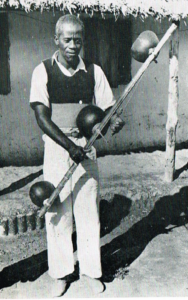
15 Epopée d’Ovang-obamo-ndong et ses guerriers 1’27 45’40
chez les immortels (avec harpe-cithare) a
Philippe Dong – voice, mvet, audience plays the sticks
Anthologie de la Vie Africaine (Congo-Gabon)
Disques Ducretet-Thomson 320 C 128 A 8
Culture Fang
recorded Herbert Pepper
https://archives.crem-cnrs.fr/archives/items/CNRSMH_E_1959_002_004_003_08/
The epic Ovang-obamo-ndong goes about how he and his people try to steal the immortality from the kingdom of Engong.

16 Louanges a la harpe sacrée Ngombi 2’59 48’39
Ngombi (harp), Obaka ( rhythm instrument made from palm leaf veins stuck in the ground)
Anthologie de la Vie Africaine (Congo-Gabon)
Disques Ducretet-Thomson 320 C 127 B 11
Location Bahoumbou
Culture Fang
recorded Herbert Pepper
https://archives.crem-cnrs.fr/archives/items/CNRSMH_E_1959_002_004_002_25/
Bwiti religion in Mitsogo language. The Ngombi harp is considered a sacred instrument and every string has special properties. This is a song directed to the harp.

17 Au-dela de la mort choeur sur un revenant 2’01 50’40
(du rite kondjo)
Female voice, Ngombi (harp), 2 Ngomwa (drums), 1 wooden small bench as percussion instrument
Anthologie de la Vie Africaine (Congo-Gabon)
Disques Ducretet-Thomson 320 C 128, B 18
Location Lambaréné
Culture Nkomi
recorded Herbert Pepper
https://archives.crem-cnrs.fr/archives/items/CNRSMH_E_1959_002_004_003_28/
Kondjo ritual association a song on the dead who come back
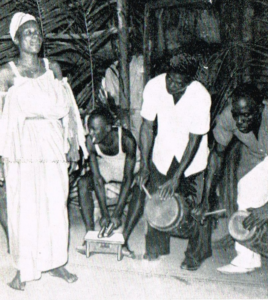
18 Dialogue avec l’esprit 3’02 53’42
voice of the spirit, a choir of men, Engama, Ngoma, Ebanjouna drums, Owaka palm leaf percussion, mirliton, kreten
Anthologie de la Vie Africaine (Congo-Gabon)
Disques Ducretet-Thomson 320 C 127 B 16
Location Lambaréné
Culture Galoa
recorded Herbert Pepper
https://archives.crem-cnrs.fr/archives/items/CNRSMH_E_1959_002_004_002_30/
Dialogue with the spirit Okouyi and a song directed to the crocodile by someone who want to ask for a judgement of the spirit on a matter and a hommage to the great master the crocodile.

19 Debut de la Seance de Kosi 9’46 64’28
Mouth bow, percussion
https://archives.crem-cnrs.fr/archives/items/CNRSMH_I_2007_010_059_03/
Location Komi
Culture Tsogho or Mitsogho
recorded by Pierre Sallée, 1967
Séance with and at François Kosi









